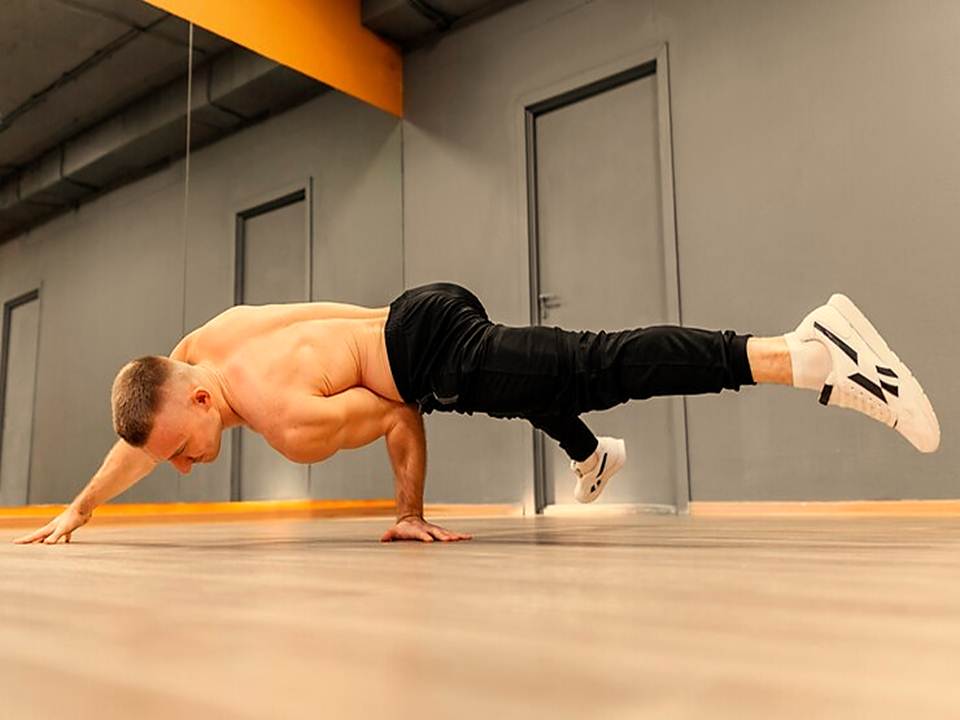A Guide to 10 Plyometric Exercises for Building Explosive Muscle Strength
When it comes to dynamic fitness, where strength and agility meet, plyometric workouts have become essential for people who want to build muscle power. In plyometrics, which is also called “jump training,” you do quick, powerful moves that use your muscles’ natural cycle of stretching and shrinking to make the most force in the shortest amount of time. This unique way of training not only gets muscles to work, but it also improves speed, coordination, and general athleticism.
As part of our “10 Plyometric Exercises to Build Muscle Power” guide, we take a closer look at plyometric exercises and present a carefully chosen list of 10 intense workouts that will help you reach new levels of muscle strength. Whether you’re a player looking to improve your game or a fitness fanatic wanting to make your workouts more intense, these plyometric exercises will help you reach your full strength and agility potential. Get ready to go on a trip that goes beyond normal ways of training as we look at the science and how to do these 10 plyometric exercises to build muscle power.
10 Plyometric Exercises to Build Muscle Power
 As exercise trends change all the time, building muscle power has become a main goal for people who want to push their bodies to their limits. Strength training has changed a lot since plyometric exercises came along. These exercises are known for being explosive and energetic. This article tells you everything you need to know about 10 carefully chosen plyometric workouts that will make your muscle strength soar to new heights.
As exercise trends change all the time, building muscle power has become a main goal for people who want to push their bodies to their limits. Strength training has changed a lot since plyometric exercises came along. These exercises are known for being explosive and energetic. This article tells you everything you need to know about 10 carefully chosen plyometric workouts that will make your muscle strength soar to new heights.
Box jumps can help you get stronger
Box jumps are one of the most basic plyometric exercises. They work the lower body and build powerful strength. This exercise is an important part of any power-building practice because it works on coordination and balance as well as major muscle groups.
Depth jumps: Going against gravity to get more power
Because deep jumps include the force of gravity, they push your muscles to use all of their strength in the shortest amount of time. People love this plyometric exercise because it helps you jump higher, which makes it an important part of building powerful lower-body strength.
Burpees: Moving Total-Body Strength
Burpees are an important part of high-intensity exercise because they work both your muscles and your heart. Through a number of explosive moves like jumps and push-ups, this full-body plyometric exercise is meant to get your heart rate up, burn calories, and build muscle power.
Doing jumping lunges can shape your legs and make you stronger
Jumping lunges work the quads, hamstrings, and glutes. They are a combination of the benefits of regular lunges and an explosive jump. Not only does this practice build muscle strength, it also improves balance and stability, which makes you a better athlete overall.
Taking medicine Ball slams: Use your whole body’s strength
 Medicine ball hits are a fun way to work out your whole body and highlight the strength you get from your core. The strong slam of the ball works the arms, shoulders, and core, making it a good plyometric exercise for building useful strength and power.
Medicine ball hits are a fun way to work out your whole body and highlight the strength you get from your core. The strong slam of the ball works the arms, shoulders, and core, making it a good plyometric exercise for building useful strength and power.
Plyometric push-ups are a new way to build upper body strength
Plyometric push-ups add an explosive element to standard upper body training that will help you get better at push-ups. This exercise strengthens the fast-twitch muscle fibers that are important for explosive power while working out the chest, shoulders, and arms.
Jump squats: Making your lower body more explosive
Jump squats are an improvement on the standard squat that make the exercise harder by adding a strong jump at the top of the move. This plyometric exercise works the main leg muscles and improves cardiovascular health. It can be used in a variety of ways to build strength.
Tuck jumps will help you get better at jumping.
The goal of tuck jumps is to get as high as possible while tucking your knees to your chest in the air. This plyometric exercise focuses on building explosive leg strength and the neuromuscular coordination that is needed to be very athletic.
Box jumps with only one leg: accuracy and strength
Single-leg box jumps are a great way to test your balance and strength in one leg. This advanced plyometric exercise focuses on each leg separately, helping you build strength in both legs equally while increasing your total strength.
Clap push-ups: quick and explosive upper body exercise
Clap push-ups are a difficult plyometric exercise that work your chest and triceps to build strength. They should be the last thing you do in your strength-building practice. The mid-air clap and rapid push-off work fast-twitch muscle fibers, which makes you stronger and more powerful.
As you start to build explosive muscle power, these 10 plyometric routines will strengthen and speed you up. Focus on proper form and progression as you add them to your workout routine. This will help your body change and grow. Remember that the key is not just how hard you work, but also how precisely and consistently you do it. With plyometric movements, you can step up your fitness game, break through fitness plateaus, and find your inner power.
Benefits of 10 Plyometric Exercises to Build Muscle Power
 Using plyometric workouts to build muscle power has many benefits that go beyond those of regular strength training. Here are the main reasons why you should include these active exercises in your workouts:
Using plyometric workouts to build muscle power has many benefits that go beyond those of regular strength training. Here are the main reasons why you should include these active exercises in your workouts:
Plyometric workouts focus on making muscles contract quickly, which helps build explosive strength. For things like running, jumping, and many sports moves that need short bursts of strength, this kind of strength is very important.
Plyometrics is a great way to improve athletic ability because it works on fast-twitch muscle fibers. The increased strength and speed that these workouts provide can help athletes in many sports, such as basketball, soccer, and track and field.
Box jumps, depth jumps, and tuck jumps are all plyometric workouts that focus on the muscles used for jumping. A good vertical jump is important for sports like basketball and volleyball, and regular practice can help you get better at it.
Because plyometric workouts are so dynamic, muscles and joints need to work together very carefully. This is a great addition to functional training because it not only improves balance but also general coordination.
High-intensity interval training (HIIT) often includes plyometric movements, which help the body burn more calories. This can help you control your weight and lose fat, so these workouts are good for people who want to get stronger and more fit.
A lot of plyometric routines work out more than one muscle group at the same time, which is good for your whole body. This keeps muscle growth even and makes sure that you have the strength to do a variety of exercises.
Plyometrics can raise your heart rate and help you get in better shape, especially when added to a fast-paced practice. Plyometric training is both time-efficient and successful because it works on both strength and cardiovascular fitness.
 Performing plyometric movements with controlled impact can help bones grow and become more dense. This is especially helpful for keeping your joints healthy and lowering your risk of getting osteoporosis, especially as you get older.
Performing plyometric movements with controlled impact can help bones grow and become more dense. This is especially helpful for keeping your joints healthy and lowering your risk of getting osteoporosis, especially as you get older.
You can change up plyometric exercises to fit your fitness level and goals. There are plyometric exercises that are good for everyone, from beginners who want to make their workouts more intense to advanced athletes who want to reach their full potential.
You can easily add plyometrics to a variety of training methods, such as strength training or bodyweight workouts. This flexibility lets you make a varied and fun fitness routine, which keeps things interesting and helps you stick with your workout plan for a long time.
Adding plyometric movements to your workout routine will help you in more ways than just building muscle. Plyometrics is a fun and effective way to reach your fitness goals, whether you’re an athlete looking to improve your ability or a fitness fanatic looking for a well-rounded and effective workout.
Conclusion:
By exploring the world of plyometric workouts, we have found a dynamic and life-changing way to build muscle strength. The 10 powerful workouts in this guide can help you reach your full potential and offer many benefits beyond regular strength training.
Incorporating plyometrics into your exercise routine will help you build explosive strength, get better at sports, and raise your vertical jump. Because these workouts work your whole body, they not only shape your muscles, but they also improve your coordination, balance, and cardiovascular fitness.
Plyometrics can be done by people of all fitness levels because they can be changed up to suit different needs. For example, beginners can do them slowly to build up their fitness, while experienced players can do them quickly to get their heart rate up. When you add these exercises to different workout routines, you get a well-rounded approach to fitness that keeps things interesting and encourages long-term commitment.
The benefits go beyond the physical, affecting bone structure, joint health, and calorie burning for people who want to be healthy all around. It’s not just a way to get stronger; plyometric training is a fun and satisfying journey that changes the way we think about strength and conditioning.
When you add these 10 plyometric exercises to your routine, keep in mind that regularity, accuracy, and a desire to keep getting better are key to success. Let out your inner strength, push past your limits, and change what your body can do. I want to go to the world of plyometrics, where powerful strength meets endless potential. Take it in stride, and your exercise journey will reach new heights.




